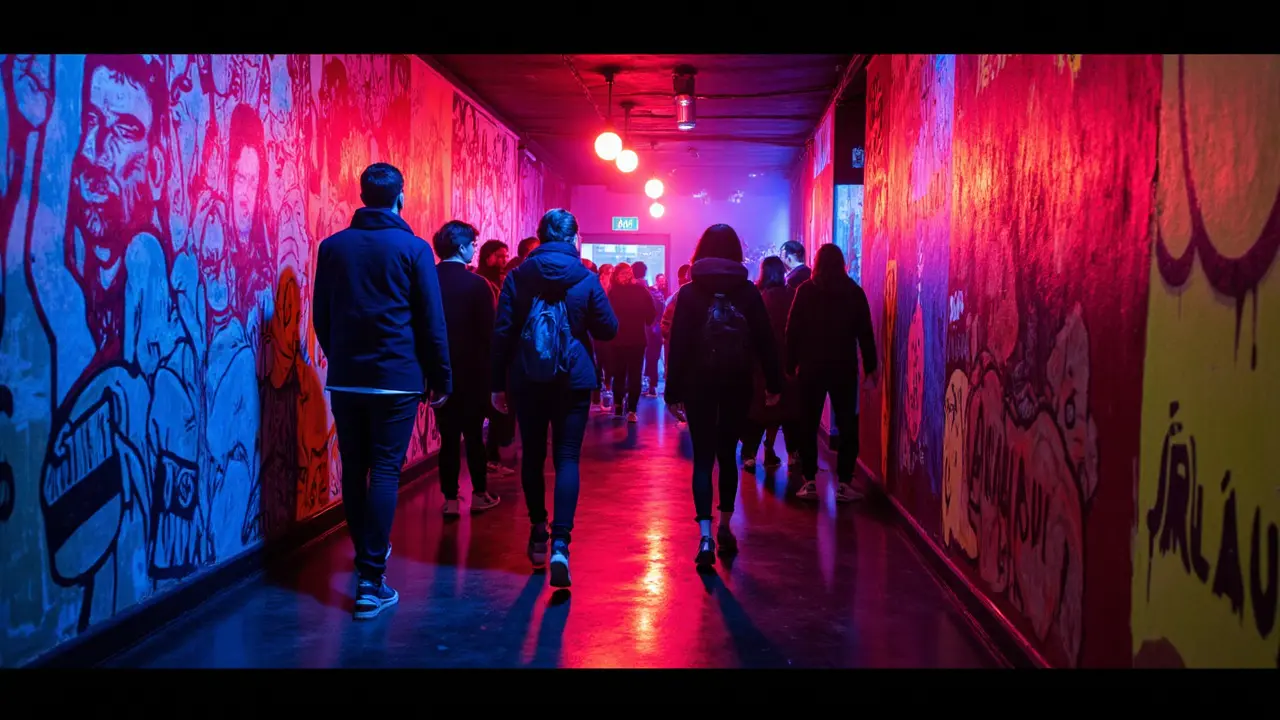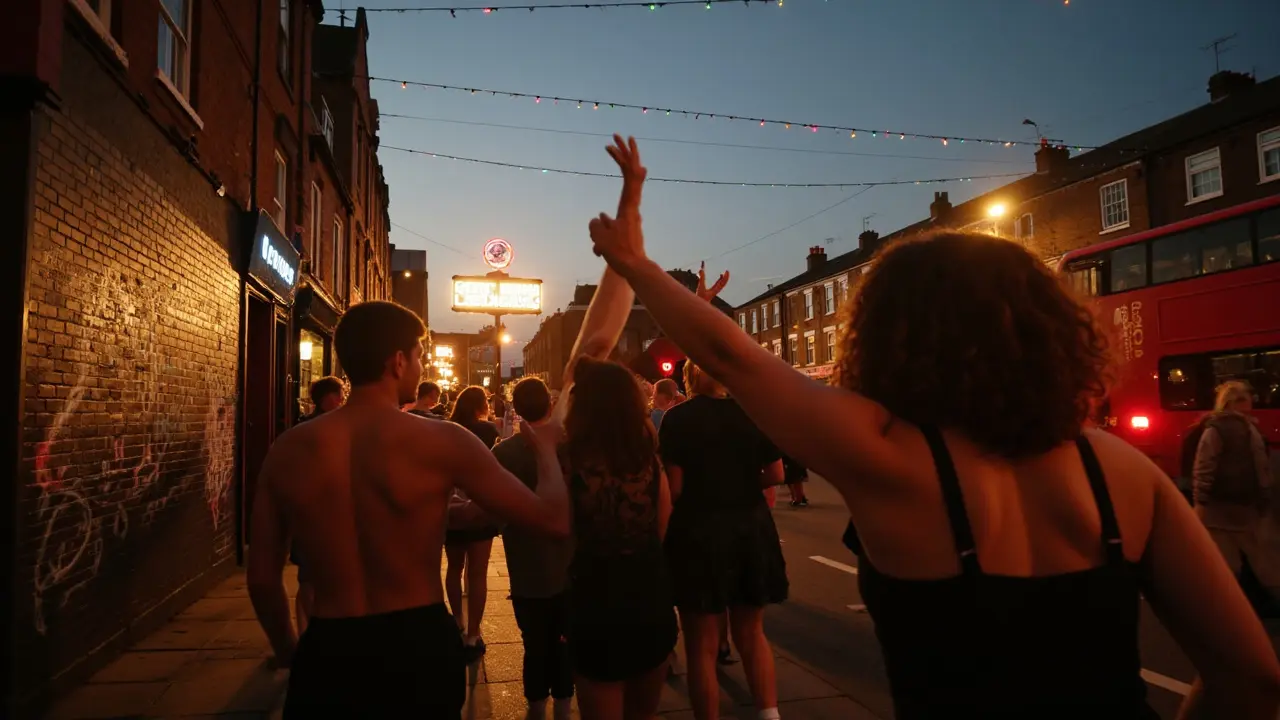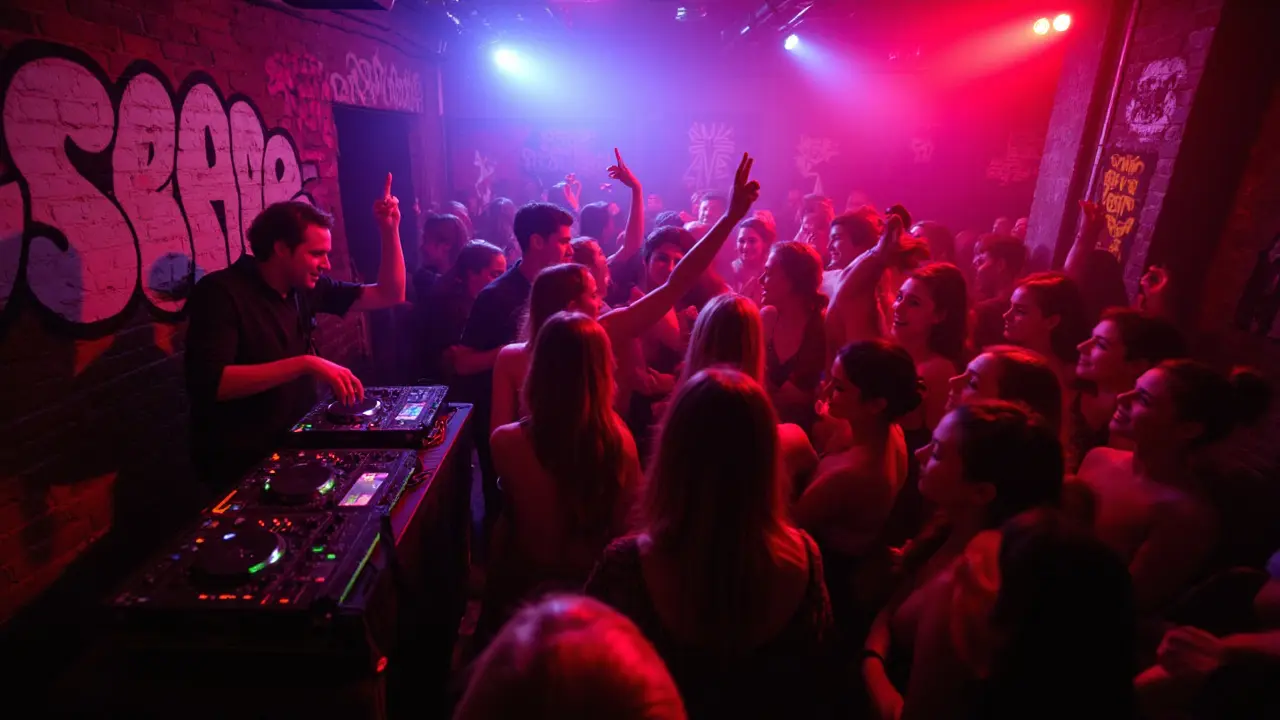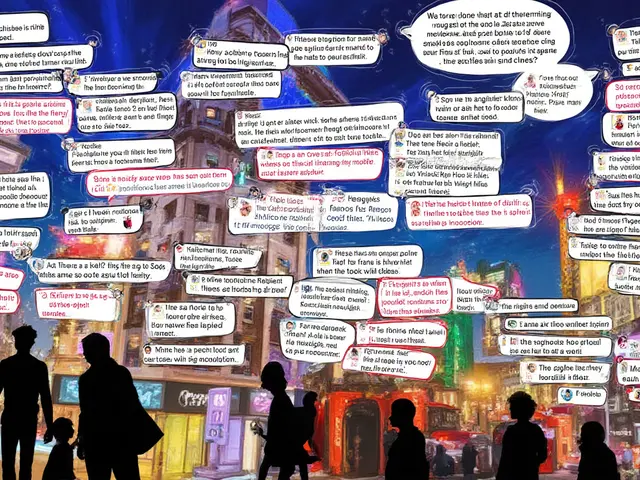Walking through Elephant and Castle at midnight, you might feel the city breathing beneath your feet. South London’s heart beats in an offbeat rhythm, magnetic and dark, right up until you step under the railway arches and hit that battered black door—Corsica Studios. Hidden just off the main drag, Corsica isn’t your standard shiny club with velvet ropes. No glitz here. Instead, you get two sweat-humid rooms, a patchwork of graffiti, locals who know their tunes, and a sound so clear and heavy that it shakes the pint glasses behind the bar. That first time inside feels a bit like ducking into a secret society: the distant rumble of trains overhead, the soft hum of anticipation, the flash of strobes bouncing off exposed brick, and a crowd that’s totally in it for the music.
Where Grit Meets Groove: The Anatomy of Corsica Studios
What makes Corsica Studios special isn’t obvious until you’ve spent a few hours moving through its spaces. The club’s split into two rooms (Room One and Room Two), both built with the sort of minimalism you hear about but rarely feel. Room One, Corsica’s core, is more like a bunker than a club: stripped back, low-lit, and always alive with a surging energy. The concrete floor sticks a bit, the walls echo with decades of sweat and laughter, and the Funktion-One sound system packs the kind of bass that thumps against your chest. They don’t crowd out the floor with bottle-service booths or ego-trip lighting rigs—the action’s always about the dance, the crowd, and the DJ.
Room Two’s got the right sort of roughness: just big enough to lose yourself, never so huge you feel anonymous. On a Saturday, you’ll find creative types swapping stories in the smoking area out back; inside, regulars mingle with new faces. Corsica’s a place where bookish students, serious crate-diggers, design nerds, and off-the-clock bartenders from every corner of the city collide. No one’s taking selfies for the sake of it. There’s an almost sacred respect for the space—no glass on the dancefloor, don’t block the doorway, and if you don’t know what tune is playing, ask someone. It’s old-school club etiquette, London-style.
If you want the numbers: Corsica Studios has a capacity of just over 500 spread between two rooms, so you get a packed, buzzing vibe without the soulless scale of bigger venues. Don’t expect to roll in after 2am—if you turn up late, you’ll queue. The reason is simple: Corsica’s curation is sharp, and lineups sell out fast. Even with the low-key branding, you’d be surprised who shows up behind the decks: Floating Points, Helena Hauff, Ben UFO, Shanti Celeste, and Midland have all played here. Sometimes, you catch a secret set—last autumn, Four Tet dropped in unannounced and played from 3 till close. Word gets around, and when it does, the energy in the rooms shifts—genuine anticipation, not hype.
A lot of clubs talk about “underground scenes” or staying independent, but Corsica really does it. The club is owned by Amanda Moss and Adrian Jones, who opened the place back in 2002 as a way to support local artists, musicians, and the wild kind of culture that can’t be contained in galleries or theatres. Most of the events are promoted by collectives and labels rather than faceless corporations—Bruk Out, Jaded, Field Maneuvers, and Mind Dance are classic names here. The crowd follows the vibe, not the brand, and there’s a strong sense that you’re part of something: dance culture with a genuine DIY heart.

DJs, Live Gigs, and the Sonic Map of Corsica
Corsica Studios doesn’t fence itself into a single music genre. On a single weekend, you might catch techno, drum & bass, UK garage, leftfield house, dancehall, or the rare live band tearing it up. The programming’s a real mix—but two things unite it: top-quality sound and a respect for the crowd’s open mind. Organisers book in underground House legends, rising grime MCs, cult punk outfits, and the latest electronic experimenters. Friday night? You could be listening to a Detroit techno all-nighter. Saturday? There’ll be a Queer Rave party soundtracked by South London collectives, complete with drag hosts and a melting pot dancefloor.
If you want pure audio facts, here’s a quick table laying out popular nights and vibes you’ll find each month:
| Night Name | Typical Genre | Hosted By | Vibe |
|---|---|---|---|
| Jaded | Techno | Jaded Crew | Sunday morning rippers, die-hard regulars |
| Bruk Out | Dancehall/Bass | Local Collectives | High energy, Caribbean roots |
| Mind Dance | House/Disco/Leftfield | Mind Dance Crew | Wild selectors, deep catalogues |
| Field Maneuvers | Varied | Festival Offshoots | Surprise lineups, family feel |
| Hush | Drum & Bass/Jungle | New Gen Promoters | Loud, relentless, raucous |
The lineups read like a who’s-who of the underground. Booking agencies use Corsica as a testing ground—the intimate setting means artists can take risks. During pandemic closures, Corsica shifted to live streams and ticketed broadcasts from the DJ booth, just to keep the music alive. When reopening, the first night back sold out in minutes, and resident DJs played tracks chosen by regulars who’d missed the place like crazy.
Sometimes, the best sets are delivered by unknown names—new residents sneaking in obscure broken-beat or acid cuts. And the lighting: don’t expect Ibiza glam. It’s functional and a bit brutal, highlighting the honest grit of everything from the bar to the battered speakers. The real magic is in the crowd’s response—no one cares if you know the track list, but they’ll cheer a good mix and break into spontaneous dance circles when the moment hits.
One quirky fact—Corsica Studios holds an annual anti-Christmas rave every December. No Mariah Carey, no plastic snowflakes, just the wildest lineup they can muster and a sense of pushing back against the classic Christmas excess. If you hate the holidays, this one's for you.

How to Make the Most of a Corsica Night
Heading down to Corsica for the first time? There are a few things you should keep in mind if you want the night to go smoothly. First, Corsica Studios is cashless at the bar—make sure your card is loaded, or you’ll be stuck sipping tap water (which, to be honest, is free and sometimes just what you need at 3am). Tickets almost always go on sale weeks in advance, so follow your favourite DJs and collectives on socials—Instagram and Resident Advisor are best for Corsica event drops. If you want to dodge the worst of the queue, arrive before midnight and bring your ID (no matter how old you look; they’re strict on entry).
If you’re worried about your hearing, bring earplugs. The sound is pristine but LOUD, and a night next to the subs can leave your ears buzzing for days. Fashion-wise, Corsica doesn’t do dress codes—you’ll see everything from trackies and tees to wild rave-wear and thrifted 90s jackets. Wear what you like, but bring layers. The smoking area can get chilly, especially in winter. Lockers are cheap and the staff don’t mind if you take short breathers outside—you’ll want a cool down after a few hours on the floor anyway.
The drinks list isn’t expensive for London: bottled beer, cider, spirits, and some surprisingly tasty cocktails if you know what to ask for (Negroni with mezcal, anyone?). Water’s free. There’s usually a pop-up food van or stall outside for late-night bites—try the vegan jerk wraps or classic chips if you’re flagging late. Security’s present but chill unless someone’s causing real headaches. As for safety, Corsica has a solid record when it comes to inclusivity and crowd management—they’ve got good policies on harassment, and there’s a “safe space” attitude inside. If you feel out of your depth, staff and security are always around.
Worried about getting home? Night buses go right from the main road, and if you’re lucky, the first tube will be running when the club closes. Apps like Citymapper will keep your night on track. Don’t expect fancy cloakrooms—they’re functional, and queues can get long, so pack light.
Here are some tried-and-tested tips to squeeze the best out of your visit:
- Buy tickets early—they go fast, especially when big names are on the bill.
- Come in a small group—a big crew can get split between rooms and lose each other in the crowd.
- Check the set times in advance, but stay flexible—pop between rooms and trust your gut (Room Two sometimes holds unexpected gems).
- Talk to strangers—Corsica’s one of the friendliest club crowds in London. You might meet your new best mate while queuing for the loo.
- If you want a break, the mural-covered walls out back are perfect for people-watching before you dive back in.
- Look out for pop-up art shows and installations—Corsica doubles as an art and performance venue, so you might catch something wild mid-rave.
A final thing I love? Every staff member, from the person pulling pints at the bar to the sound engineer in the corner, seems genuinely proud to keep Corsica ticking. The club’s always evolving—right now, they’re trialing new nights to cater to different South London micro-scenes, and every year new promoters come in to shake things up. Even my cat Luna, without ever stepping foot inside, seems to sense something’s up when I stumble home buzzing at 7am, trainers sticky and ears full of rhythm.
Corsica Studios is the proof that London’s best nights aren’t about exclusivity or glitzy status—they’re about unfiltered music, honest energy, and dancing with strangers who feel like old friends. If sleep can wait and you want soul in your nightlife, you’ll find it under those railway arches.








10 Comments
Oskar Banaszek
August 4, 2025 AT 14:36Honestly, Corsica Studios is way overrated. Everyone talks about it like it's some divine underground temple. Personally, it's just another dimly lit London club with a trying-too-hard vibe.
The music sometimes is decent, sure, but let's not kid ourselves that it’s some life-altering, soul-enriching experience. It’s crowded mostly with hipsters trying to be ‘in the know’ rather than actual music aficionados.
Don't get me wrong, I appreciate a good underground spot, but Corsica Studios? Not the gem everyone seems to think it is. There are far better places in London if you're truly into raw, authentic sounds.
So yeah, if you're expecting a nightclub holy grail, you might want to temper your expectations.
Travis Reeser
August 4, 2025 AT 15:36Hey, I get where you're coming from, but I think Corsica Studios offers something unique despite the popular opinions.
It's not just about the surface — the crowd, the dim lighting. What really makes it stand out is the rawness and authenticity of the music itself, the kind you don't always find in bigger, more commercial clubs.
Plus, the art on the walls blends perfectly with the vibe, creating an immersive experience. It's a spot where you genuinely feel the culture pulsing through every beat.
Sure, it’s not for everyone, but for those who appreciate the underground scene, it’s a gem worth visiting.
Kevin Puls
August 4, 2025 AT 16:36I’d like to add that from an expert perspective on electronic music venues, Corsica Studios is notable for maintaining a niche that London desperately needs.
While commercial clubs tend to prioritize mainstream appeal and profit, Corsica Studios keeps the underground spirit alive.
The sound system is well-tuned for the genres they host, and the venue layout encourages connection and energy-sharing rather than just a passive dance environment.
It's a carefully curated space that respects both the artist and the audience, unlike many other venues that commercialize the experience.
So for anyone serious about the culture and quality, Corsica definitely deserves recognition.
Ariella Silver
August 4, 2025 AT 17:38From a slightly different angle, I’ve always thought that Corsica Studios embodies a fascinating duality.
Yes, it is gritty, raw, and definitely underground, but it also strangely feels like a warm refuge for those seeking to escape the commercialized nightlife that saturates London now.
There’s a soulful pulse not just in the music, but the collective energy of the crowd and the artistic expressions decorating the space.
It’s not a place for everyone, especially if you’re after luxury or polish, but rather a sanctuary for those who find beauty in imperfections and the ephemeral magic of live, spontaneous connection.
In a city filled with cookie-cutter clubs, places like this are essential.
Gerald White
August 4, 2025 AT 18:38Okay but like, have you considered that all this hype is just a setup for something bigger yet hidden, right? What if Corsica Studios is not just a club but some secret base for mysterious underground operations? I mean, the vibe is suspiciously intense, the art is almost too raw… Seems like there’s some drama brewing behind the scenes.
Also, think about it, crowds staying till sunrise? Sounds like people are entranced or something, not just partying. What kind of 'soulful experience' is that? Feels more like brainwashing.
Maybe I’m just paranoid but still, keep your eyes open when you go. Things aren’t always what they seem in these underground scenes.
Ankit Chamaria
August 4, 2025 AT 19:38That conspiracy angle is hilarious but I have to say, the culture Corsica Studios fosters is genuinely inclusive and underground in spirit. I've found the people there very welcoming to newcomers and the music really raw, unpolished in the best possible way.
It's not about flashy lights or big-name DJs; it's about shared experiences and discovering sounds that challenge you. Honestly, places like this define the real 'nightlife' beyond the surface glamour.
Plus, the art? Man, it’s edgy, giving this really authentic vibe – you can literally see the soul of the artists in the walls.
Maybe that’s why people stay till sunrise – because they’re hooked on something deeper than just a dance floor.
Definitely worth it for those who seek that real connection.
jasper watervoort
August 4, 2025 AT 20:38I've been there few times, and honestly the vibe is really chill. Not much fancy stuff but you get real beats and a crowd that is there cause they love the music, not just to dance or show off.
It feels more relaxed, like a place where DJs can experiment with their sound and people listen carefully.
The art is cool too, adds some personality.
Maybe not everyone's cup of tea if you're looking for big flashy parties, but if you want an authentic underground experience in London, it's a solid pick.
Johanna Iñiguez
August 4, 2025 AT 21:38While the description is evocative, I must object to the lack of clarity and precision in relating what exactly constitutes this "soulful experience." Moreover, presumably "raw" sound in such venues sometimes lapses into muddled acoustics rather than authentic artistic expression.
Corsica Studios certainly possesses a cultural pedigree as an underground club. Yet, to describe the crowd as staying until sunrise requires substantiation. Are we to believe this is a norm or an exception?
Finally, it is crucial to differentiate between atmospherics and actual musical quality when recommending such venues.
One hopes future write-ups provide more detailed and structured insights.
desiree marin parraga
August 4, 2025 AT 22:40OMG, I absolutely LOVE Corsica Studios!! It’s like THE ultimate secret spot where you can actually feel the music shooting straight into your soul. The crowd is so alive and full of energy, it’s impossible not to get swept up into the vibe.
And don’t even get me started on the art on the walls – it’s like stepping into a living gallery that keeps your eyes glued even when you wanna just dance.
This place totally shattered my expectations of London nightlife. You come out feeling like you’ve participated in something magical, not just another party.
If you haven’t been, you’re seriously missing out!! I’m counting the days to the next event.
mahendra kushwaha
August 4, 2025 AT 23:40As an aficionado of cultural venues, I find Corsica Studios to be a concise embodiment of what London's underground agenda strives to sustain.
Its commitment to non-mainstream music and art synergizes perfectly with the historical exploration of alternative cultural expressions.
The evening hours stretching till dawn create a temporal space where artistic boundaries dissolve and genuine interaction flourishes.
This sanctuary, albeit modest in scale, commands respect and deserves continued patronage from serious enthusiasts of music and urban culture alike.
It remains a necessary jewel in London's vibrant but sometimes overly commercial nightlife crown.